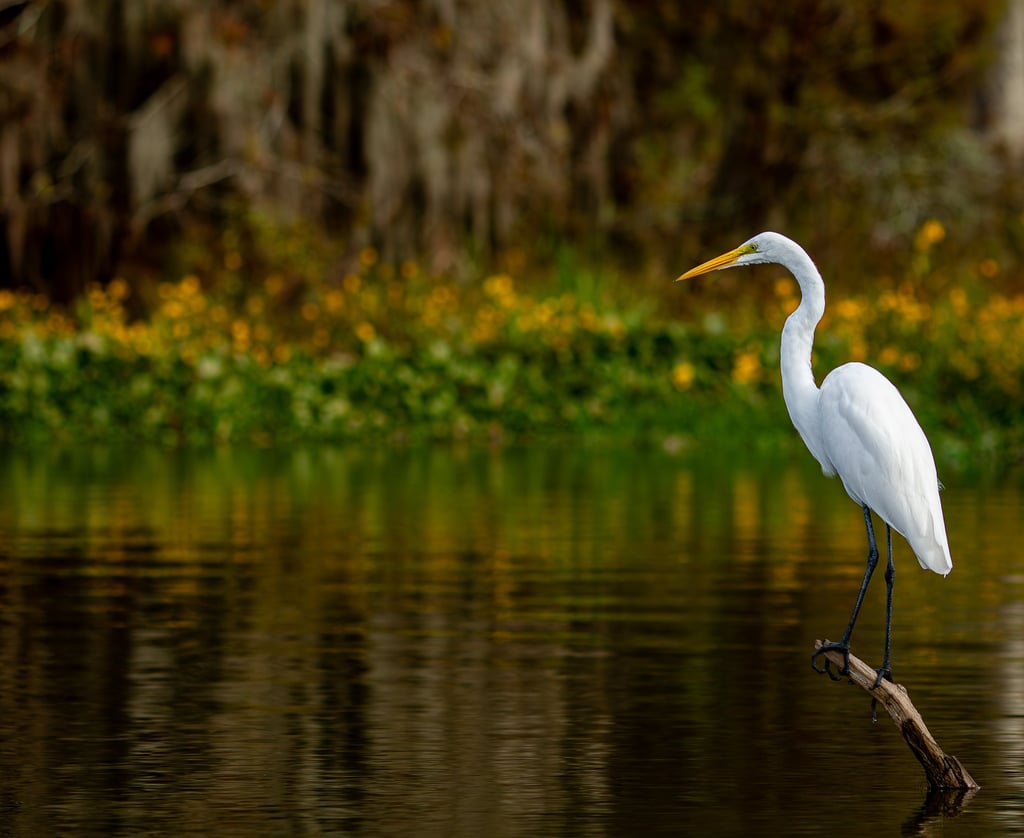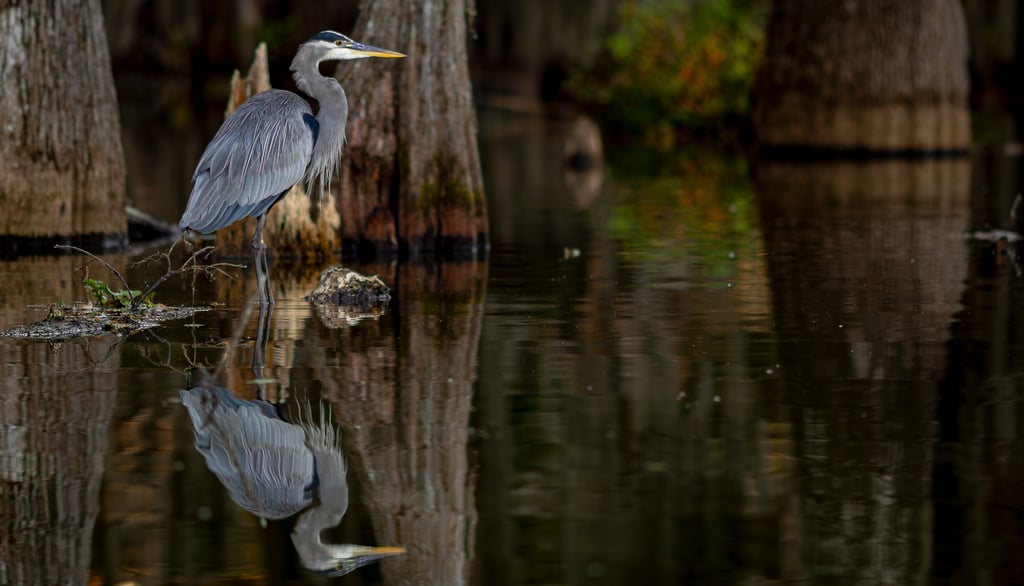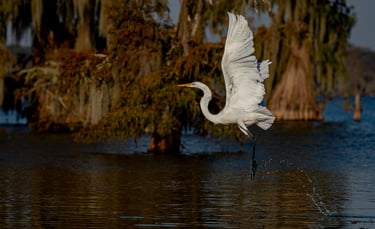Call Now to Empower your Adventures! 337-247-7249


As birding grows in popularity, more people are trying their hand at wildlife photography. Today I hope to share some tricks of the trade that I’ve acquired over the past few years in hopes of encouraging more beginners to push their newfound passions further. To even approach such a broad subject without overwhelming people with too many details, I plan on limiting this discussion to a single location nestled in the heart of Cajun Country: Lake Martin.
Located just outside of Breaux Bridge, LA, lies a cypress-tupelo swamp teeming with wildlife and drenched in atmosphere. Part of the Cypress Island Preserve, this region is renowned among birders and photographers alike for its rich biodiversity and hauntingly beautiful landscapes. With its dramatic backdrops of moss-draped trees and beautiful reflections, Lake Martin is more than just a good spot for bird photography, it’s an immersive natural experience. For those who approach the craft not just as photographers but also as students of the natural world, the rewards are especially rich. Understanding the environment and the creatures that live within it transforms photography from just a technical pursuit into a deeper form of storytelling.
For bird photographers, the basics start with gear. A good DSLR or mirrorless camera with fast auto-focus and strong burst capabilities is essential. There’s no need to get the latest, greatest camera though; I shoot most of my wildlife photos with a Canon 7D MkII from 2014 (11+ years old). Since I like to take pictures from a kayak, I don’t like the idea of risking thousands of dollars worth of brand new gear, so an older camera is a better fit for me. Shooting from a kayak opens up many more angles for light and water reflections, as well as allows me to get closer to my subjects, so for me it's worth the trade off.
Photography settings will vary depending on the situation. For action shots, like birds in flight, you’ll want a shutter speed of at least 1/2000 to freeze motion, paired with an aperture around f/5.6 to f/8 to maintain depth and sharpness. This combination can be tricky as higher f/stops usually mean slower shutter speeds. This is particularly challenging during dusk and dawn when a higher ISO is often the only option. In the dim early morning light of Lake Martin, for example, you might start with ISO 800 or higher and adjust from there. For more static shots, like a heron perched on a branch or a duck preening, a shutter speed of 1/500 will usually suffice. Lower your ISO as much as possible for cleaner images, and consider using single-point auto-focus to lock precisely on the subject’s eye. Don’t be discouraged by images with too much noise; while you can't fix out-of-focus shots or motion blur in post. In contrast, noise reduction is quite easy with most modern editing programs.
Next comes the lens, which might surprise you by costing more than the camera. Ideally, you’d want to pair your camera body with a telephoto lens (300mm or longer) to maintain distance without sacrificing detail. Crop-sensor cameras, like the Canon 7D mkII, multiply the focal length by 1.6x. This means a 200mm lens on a crop sensor camera will effectively be about 320mm, allowing you a bit more reach. Birds can be easily scared off, so being able to put some distance between you and the bird usually leads to more natural looking activity. Longer lenses will need more support in a kayak, so a mono-pod or tripod can be helpful, especially in low-light swamp conditions. It’s highly recommended to use a lens with a tripod mount, as mounting to the camera body directly won't be nearly as balanced or stable. Binoculars are also invaluable for scouting and identifying birds before even lifting your camera. Understanding your subject truly elevates your images, and that’s where the naturalist mindset comes in handy.


Knowing how to use your camera is only half the story. The real magic begins when you start understanding your subject and setting better. Lake Martin is home to over 100 species of birds, from majestic great egrets and roseate spoonbills to secretive yellow-crowned night herons and even the barred owl. Spring, especially from March to May, is peak nesting season, making it one of the best times to go birding. Early morning is ideal for the warm, directional light and ethereal mist rising from the swamp. Late afternoon also offers great opportunities as the light softens and birds return to roost. The “golden hour” you hear people referring to has more to do with the angle of the light than the actual color. Your goal is to have the light behind you, so that your shadow points towards your subject. The lower the sun is on the horizon, the more dramatic this effect can be. Light can be less than flattering when coming from directly above during mid day hours. To consistently find and photograph birds, it helps enormously to become a naturalist. Knowing bird calls, migration patterns, and general behavior patterns allows you to anticipate action before it happens. You learn that birds often follow repeatable flight paths or that certain trees serve as regular roosts. This awareness leads to more than just photo opportunities; it leads to authentic images that tell a story.
Composition also plays a crucial role. Placing the subject off-center using the rule of thirds often results in more dynamic images. A shallow depth of field can help isolate your subject from a cluttered background. Sometimes, however, including more of the environment, like cypress limbs or reflections of Spanish moss, adds depth and narrative. A bird mid-flight is exciting, but capturing it at sunrise, lifting off with mist swirling around, tells a story. Always ask yourself: What am I trying to say here?
Ethics are vital in bird photography. Respect for wildlife and the ecosystem should guide every outing. Keep a respectful distance; especially during breeding season. Use long lenses rather than approaching too closely. Stick to the marked paths; use approved kayak launches, and never disturb nesting sites. The more you immerse yourself in the world of bird photography, the more meaningful your work becomes.
In the end, bird photography is about more than just technical perfection. It’s about connecting a place, a subject, and a moment to the viewer. With patience, curiosity, and respect for the natural world, you’ll not only capture striking images but also gain a deeper appreciation for the rhythms of life in Louisiana’s wetlands. So grab your camera; hit the trails or the water, and let your curiosity guide you. Whether you're capturing birds in-flight or watching one quietly roost, let every shot you take tell a story.
Happy Shooting!


Capturing Their Stories
A naturalist's guide to bird photography
Andre Angelle
6/9/20255 min read